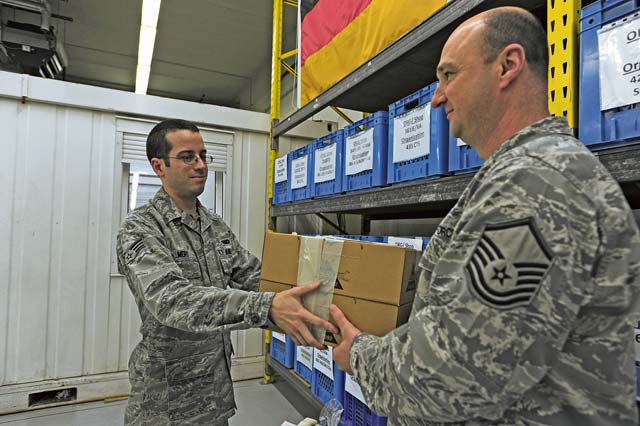
The more than 50 units assigned to Ramstein Air Base, including geographically separated units, require well-trained, physically and mentally ready Airmen. In order for Airmen to be deployment ready, units like the 86th Logistics Readiness Squadron need aggressive, straight forward and driven unit deployment managers.
The UDMs of the LRS help their fellow Airmen become deployed expeditionary Airmen, keeping the mission going all around the world.
“The main duty of a UDM is to get the deployer downrange with all their proper training and gear,” said Master Sgt. Kenneth Pruett, 86th LRS UDM. “To be a UDM you have to be a self-starter and direct, even to people who may outrank you. You need to be a motivated individual.”
The motivation to guide Airmen in the right direction so they hit the ground running during their deployment can mean the difference between a strong unit and a weak one. Keeping track of more than 300 military members from the 86th LRS might sound hard to some, but the UDMs assigned to the squadron get the job done. Tracking Airmen of multiple career fields from the beginning is a key to their success.
“In LRS, we have seven different (career fields), and when we receive a tasking, for example supply, we send it to the flight chief,” said Tech Sgt. Wakanda Benniefield, 86th LRS UDM. “Each person is assigned to a deployment band and unit type code, and based off of the band you are in, the flight chief will determine who is picked for that tasking. We are the liaisons between the flights and their flight chiefs.”
Once individuals are chosen for deployments, the UDMs can start the appropriate training that is needed. Making sure deploying individuals get the right information in a timely manner, the LRS UDMs have monthly meetings where LRS deployers, leaving at the same time, can gather information and get to know each other.
“I wanted to be a UDM because I wanted to help our UDM office be better,” Benniefield said. “I helped develop our own in-house, once-a-month training so members can come and see who is deploying in the same month they are leaving and network with each other.”
During training, younger Airmen can bounce questions off their more experienced peers. The first-time deployers can also get a grasp of deployed life from their more seasoned counterparts.
“Now if someone is uncomfortable or doesn’t ask me the right question, they can ask one of their peers,” Benniefield said. “It helps us know the right things get done because some first-time deployers might not know what to ask.”
The UDMs are not only here to make sure the Airmen are deployment ready, but also their families. Giving the loved ones back home all the right information beforehand might help make the rough times smoother.
“When you think about deploying, it’s not just the person deploying, it’s their families as well,” Benniefield said. “You want to make sure they are trained and equipped to go downrange and make sure their families and loved ones who are left home are good to go. We try to make that transition as smooth as possible.”
Using passion for helping Airmen and motivation to keep the mission going, LRS UDMs produce individuals ready to support any contingency operation.


